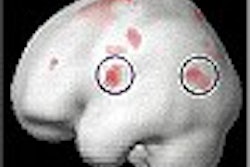SAN DIEGO - Knowing your metabolites is the key to successful MR spectroscopy (MRS) of brain tumors. In a presentation Sunday at the American Roentgen Ray Society meeting, Dr. J. Keith Smith, Ph.D., offered attendees a crash course in the basics of single and multivolume MRS.
"We’re all used to looking at (MR) images, so when we start to look at all these squiggly lines (of spectroscopy), it gets a little confusing," said Smith, who is at the University of North Carolina School of Medicine in Chapel Hill.
MRS works by measuring the resonance frequency of an atomic nucleus, which depends on its chemical environment. The nuclei return to their original position after spinning inside the magnetic field, then Fourier transformation converts the frequency information into a signal intensity plot. The frequencies (or chemical shifts) are described in parts per million (ppm), and are compared with a reference standard.
Because the concentration of water is about 100,000 times the concentration of other metabolites, a chemical shift-selective excitation technique (CHESS) is used to suppress the water signal, Smith explained. Voxel-based localization techniques are then used.
"We formerly only had the single-volume localization techniques, and that gave you a pretty good picture," Smith said. "Now, we’ve shifted to using multivolume, two-dimensional MRS to acquire a larger area. This is nice because we get not only the spectra from the lesion itself, but the spectra from the surrounding tissue."
Smith then outlined the metabolites that are important to MRS, starting with choline (Cho), which resonates, or peaks, at 3.2 ppm. Choline increases with tumor cell proliferation, he said.
Next is creatine (Cr), peaking at 3.03 ppm. Creatine serves as a reserve for high-energy phosphates and remains stable in most diseases, so it is generally used as a control for comparison with other metabolites, Smith explained.
N-acetylaspartate (NAA) resonates at 2.0 ppm and is present inside normal neurons. It is usually absent in non-glial and non-neural tumors.
Myo-inositol peaks at 3.56 ppm. It is a marker of gliosis and may be specific to low-grade gliomas, Smith said.
Lipids produce peaks ranging from 0.8 to 6 ppm, and levels of these metabolites are increased in patients with high-grade gliomas, possibly indicating necrosis. However, Smith warned that lipid resonances might also result from fat contamination.
Lactate (1.32 ppm) is not normally present in adult brain tissue. A signal from this metabolite can indicate tissue necrosis as well as anaerobic metabolism, commonly seen in breast cancer and infarcts. The function of the amino acid alanine (1.3-1.4 ppm) is uncertain, Smith said, but appears in the same area as lactate.
Finally, glutamate and glutamine are two metabolites that resonate closely at peaks varying from 2.1-2.5 ppm. Glutamate is an excitatory neurotransmitter, while glutamine plays a role in neurotransmitter regulation.
Smith discussed some of the clinical applications for MRS brain tumor evaluation. Low-grade gliomas, such as astrocytomas, show a significant reduction of NAA (40-70% below normal), which most likely indicates a loss of normal neurons. These patients also may have marked elevations of myo-inositol.
For high-grade tumors such as glioblastoma, MRS will reveal an increased choline level, a decreased creatine level, and a low NAA. A markedly high choline signal and the absence of NAA can help clinicians distinguish meningioma from other high-grade tumors, Smith said.
In terms of treatment monitoring, MRS offers certain advantages over CT, PET, or standard MR as imaging with the latter modalities may not distinguish radiation necrosis from residual or recurrent tumors. In patients with recurrence, MRS will reveal elevated levels of choline-NAA, choline-creatine, and lactate.
One pitfall of MRS is distinguishing recurrence from post-treatment radiosurgery, as both result in increased choline levels. This may be caused by an inflammatory infiltration around the edge of the treated area, Smith said.
Smith concluded with a brief talk on the future directions of MRS. In-vivo 2-D spectral imaging will enhance the coupling effects of metabolites, resulting in greater specificity, he said. Three-dimensional localized spectroscopy is already in use for treatment planning, which combines MRS metabolite information with the radiation-planning field.
"It basically produces what looks like a topographical map, a color-coded choline map, which automatically extracts the peak areas," Smith said. "The whole brain can then be imaged in 10-15 minutes."
By Shalmali Pal
AuntMinnie.com staff writer
May 4, 2003
Related Reading
MR spectroscopy reveals reduced neuronal viability in ADHD kids, March 18, 2003
MR spectroscopy provides noninvasive prostate cancer staging. December 5, 2002
MR spectroscopy again links choline to carcinoma, October 9, 2002
Copyright © 2003 AuntMinnie.com


.fFmgij6Hin.png?auto=compress%2Cformat&fit=crop&h=100&q=70&w=100)





.fFmgij6Hin.png?auto=compress%2Cformat&fit=crop&h=167&q=70&w=250)











